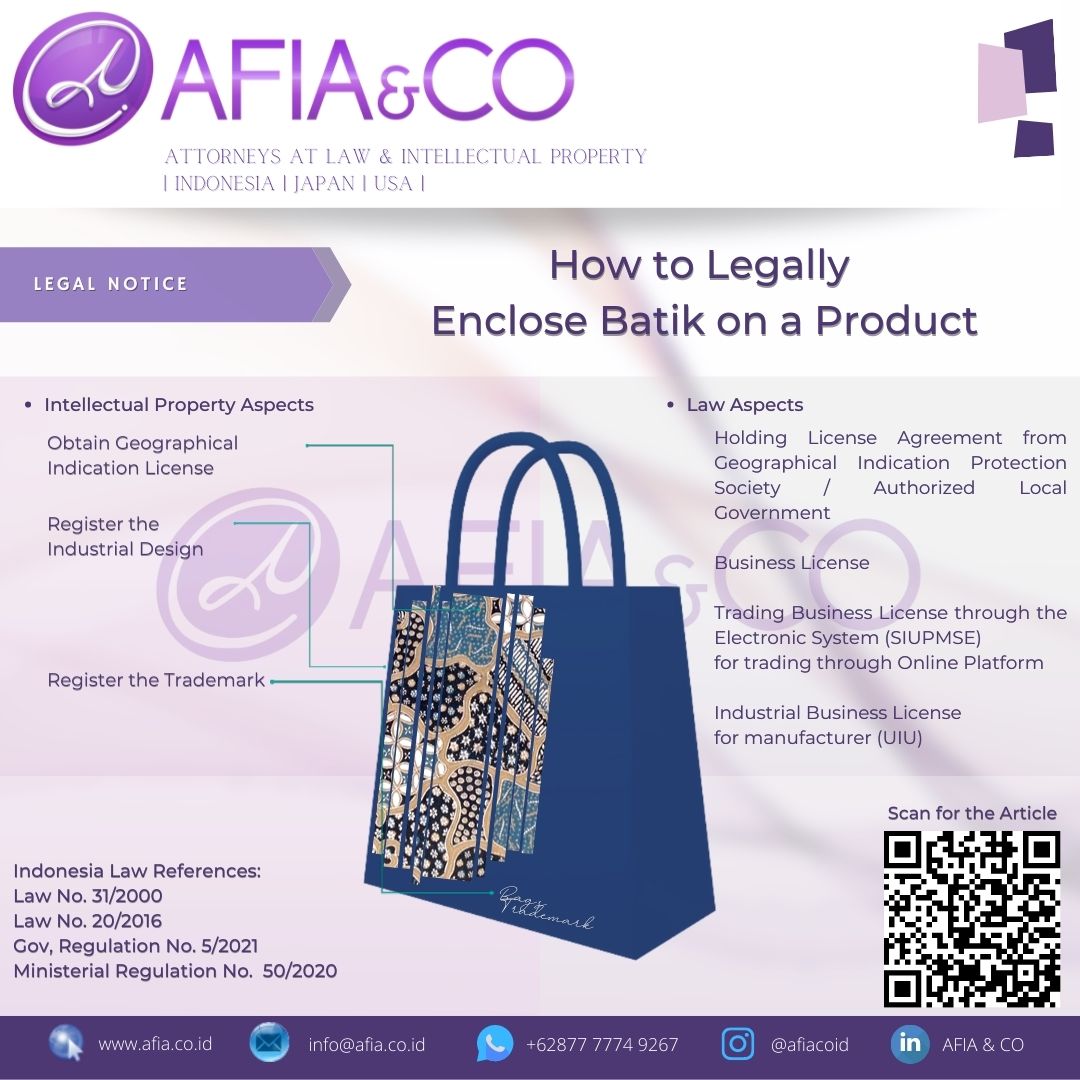Cinematography Legal Protection Against Piracy on Internet Sites
Author: Fitriyani Wospakrik
Dasar Hukum
- Undang-Undang Nomor 28 Tahun 2014 Tentang Hak Cipta.
- Undang-undang nomor 11 tahun 2008 Tentang Informasi dan Transaksi Elektronik
Legal Ground Basis
- Law Number 28 of 2014 concerning Copyright.
- Law Number 11 of 2008 concerning Information and Electronic Transaction
Hak Cipta menurut Pasal 1angka1 Undang-Undang Nomor 28 Tahun 2014 Tentang Hak Cipta adalah hak eksklusif pencipta yang timbul secara otomatis berdasarkan prinsip deklaratif setelah suatu ciptaan diwujudkan dalam bentuk nyata tanpa mengurangi pembatasan sesuai dengan ketentuan peraturan perundang-undangan.
Karya Sinematografi merupakan salah satu objek Hak Cipta. “karya sinematografi” adalah ciptaan yang berupa gambar bergerak (moving images) antara lain film dokumenter, film iklan, reportase atau film cerita yang dibuat dengan skenario, dan film kartun.
Akhir-akhir ini Di Internet banyak terjadi kegiatan mengunduh atau menonton film dari dari Internet sebagai contoh di website, ataupun di platform sosial media seperti tiktok, Instagram, telegram dengan tidak berbayar atau secara gratis dan juga tidak memiliki izin dari pemegang hak atau bisa dikenal dengan film bajakan.
Pembajakan Film merupakan aksi pelanggaran Hak Cipta Terhadap karya Sinematografi. Pembajakan diartikan sebagaiPenggandaan Ciptaan dan/atau produk Hak Terkait secara tidak sah dan pendistribusian barang hasil penggandaan dimaksud secara luas untuk memperoleh keuntungan ekonomi. Pasal 1 angka 23 UU Hak Cipta.
Copyright according to Article 1 point 1 of Law Number 28 of 2014 concerning Copyright is the exclusive right of the creator that arises automatically based on declarative principles after a work is manifested in a tangible form without reducing restrictions in accordance with the provisions of laws and regulations.
Cinematographic works are one of the objects of Copyright. “cinematographic works” are creations in the form of moving images, including documentaries, advertising films, reports or story films made with a screenplay, and cartoons.
Recently on the Internet, there have been many activities to download or watch movies from the Internet, for example on websites, or on social media platforms such as TikTok, Instagram, Telegram for free and also without permission from the rights holder or can be known as pirated movies.
Film piracy is an act of copyright infringement against cinematographic works. Piracy is defined as Illegal duplicating of Works and/or Related Rights products and distribution of goods resulting from such reproductions is widely intended to obtain economic benefits. Article 1 number 23 of the Copyright Law.
Media Over The Top
Saat ini, menonton film dapat dilakukan secara online melalui aplikasi yang menyediakan layanan streaming film secara legal yang dapat diakses menggunakan internet. Hal tersebut merupakan salah satu bentuk layanan over the top(OTT). Contoh platform OTT yang telah secara legal membuka layanan VoD untuk menayangkan film-film Indonesia, di antaranya: Genflix, Iflix, HOOQ, VIU, Vidio, GoPlay, Netflix, dll
- Licensing izin, lisensi berbayar yang diberikan oleh pemilik/pemegang Hak Cipta kepada penyedia layanan OTT
- Concession konsep, konsep bagi hasil yang dilakukan antara penyedia OTT dan pemilik/pemegang Hak Cipta dengan melakukan perjanjian tersendiri
- Advertising konsep, pemberian revenue atas Hak Cipta yang dimonetisasi lewat iklaniklan yang ditayangkan pada platform OTT
OTT membeli lisensi dari pemilik/pemegang Hak Cipta untuk menayangkan tontonan selama beberapa tahun di wilayah tertentu. sehingga mekanisme yang dilakukan bukan merupakan pelanggaran atas Hak Cipta.
Media Over The Top
Currently, watching movies can be done online through applications that provide legal movie streaming services that can be accessed using the internet. This is a form of over the top (OTT) service. Examples of platforms OTT which has been legally opened VoD service for films, Indonesia Movies, among them: Genflix, Iflix, HOOQ, VIU, Vidio, GoPlay, Netflix, etc
- Licensing, A paid license lgranted by the owner/holder of Copyright to service providers OTT
- Concession profit divide concept, concept of profit sharing concept carried out between the OTT provider and the owner/holder Copyright by entering into a separate agreement
- Advertising concept of awarding revenue Providing revenue for Copyrights that are monetized through advertisements that are displayed on the OTT platform
OTT purchased a license from the owner / holder of copyright to broadcast the spectacle for several years in a certain area. so that the mechanism carried out does not constitute a copyright infringement.
Unsur Perlindungan Terhadap Hak Cipta
Perlindungan hukum terhadap hak cipta merupakan suatu sitem hukum yang mana terdiri dari unsur-unsur sebagai berikut:
- Subjek Perlindungan, orang yang memimpin dan mengawasi penyelesaian seluruh ciptaan atau orang yang merancang ciptaan adalah produser (Pasal 34 UU hak Cipta), kecuali diperjanjikan lain pemegang hak cipta yaitu rumah produksi (Pasal 36 UU Hak Cipta)
- Objek Perlindungan, Soundtrack film, desain grafis, buku, naskah
- Pendaftaran perindungan, Hak cipta yang dilindungi hanya hak cipta yang sudah didaftarkan dan harus dibuktikan dengan adanya sertifikat pendaftaran
- Jangka Waktu, 50 tahun sejak pertama kali dilakukan pengumuman. (Pasal 58 ayat (3) UU Hak Cipta)
- Tindakan Hukum Perlidungan, Bila terbukti telah terjadi pelanggaran hak cipta, maka orang yang melanggar harus dihukum, baik secara perdata maupun secara pidana.
PERLINDUNGAN HUKUM
- Perlindungan Preventif, merupakan tindakan pencegahan Untuk mencegah terjadinya pelanggaran Hak Cipta.
Untuk mencegah pelanggaran Hak Cipta dan Hak Terkait melalui sarana berbasis teknologi informasi, Pemerintah berwenang melakukan:
- pengawasan terhadap pembuatan dan penyebarluasan konten pelanggaran Hak Cipta dan Hak Terkait;
- kerja sama dan koordinasi dengan berbagai pihak, baik dalam maupun luar negeri dalam pencegahan pembuatan dan penyebarluasan konten pelanggaran Hak Cipta dan Hak Terkait; dan
- pengawasan terhadap tindakan perekaman dengan menggunakan media apapun terhadap Ciptaan dan produk Hak Terkait di tempat pertunjukan.
- Perlindungan Represif, merupakan upaya penegakan hukum terhdapa pelanggaran hak cipta baik secara pidana maupun perdata
- Kemenkominfo dan Kementrian Hukum dan HAM memblokir situs-situs yang memuat film-film bajakan
- ketentuan pidana pada persoalan situs/website film bajakan di internet yaitu diatur dalam pasal 113 ayat (3) dan dalam pasal 113 ayat (4).
- Pemegang hak cipta, pencipta, dan/atau pemilik hak terkait dapat melakukan gugatan keperdataan ke Pengadilan Niaga jika dia merasa haknya telah dilanggar atau dirugikan oleh pihak yang melakukan perbuatan pelanggaran hak cipta diatur dalamdalam pasal 99 ayat (1) Undang-Undang Nomor 28 Tahun 2014 Tentang Hak Cipta.
- Pasal 25 Undang-Undang Nomor 11 Tahun 2008 tentang Informasi dan Transaksi Elektronik
Elements of Copyright Protection
Legal protection of copyright is a legal system which consists of the following elements:
- Protection Subject, People who lead and supervise completion of the whole creation or person It is the producer who designs the creation. (Article 34 of the Copyright Law), unless agreed otherwise by the copyright holder, namely the production house (Article 36 of the Copyright Law)
- Protection Objects, Movie soundtracks, graphic designs, books, scripts, etc
- Registration of Protection, Copyrights are only protected by copyrights that have been registered and must be proven by a registration certificate
- Protection Period, 50 years since the announcement (Article 58 paragraph (3) of the Copyright Law)
- Legal Protection Actions
The person who commit copyright infringement must be punished, both civilly and criminally.
LEGAL PROTECTION
- Preventive Protection is a preventive measure to prevent copyright infringement
To prevent infringement of Copyright and Related Rights through information technology-based means, the Government is authorized to:
- supervision of the creation and dissemination of copyright infringing content and Related Rights;
- cooperation and coordination with various parties, both at home and abroad in preventing the creation and dissemination of content that violates Copyright and Related Rights; and
- supervision of the act of recording using any media on the Works and Related Rights products in place
- Repressive Protection: law enforcement efforts to enforce the law against copyright infringement
- The Ministry of Communication and Information and the Ministry of Law and Human Rights block websites that contain pirated films
- Criminal provisions on the issue of pirated film sites/websites on the internet are regulated in Article 113 paragraph (3) and Article 113 paragraph (4).
- Copyright holders, creators, and/or related rights owners can file a civil lawsuit to the Commercial Court if he feels that his rights have been violated or harmed by the party committing the copyright infringement as regulated in article 99 paragraph (1) of Law Number 28 of 2014 About Copyright.
- Article 25 of Law Number 11 of 2008 concerning Information and Electronic Transactions





